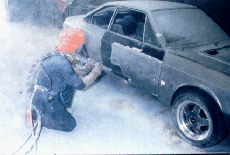Plastic Media Paint Stripping
Carstrip Pty. Ltd.
| Carstrip Pty. Ltd. has established a dry process
for stripping paint from motor vehicles undergoing
panel repairs or restoration. The process uses ground
plastic media in a sandblasting-type process to
remove the paint from the vehicle without damaging
the metal. The process has eliminated the generation
of waste sludge associated with chemical stripping
processes, and has reduced the labour requirement for
stripping a vehicle. |
Contact
- Mr John Marion
- Carstrip Pty. Ltd.
- 1/40 Adrian Road
- Campbellfield Victoria 3061
- Ph: 61 3 93578936
- Fax: 61 3 93579228
Background
Carstrip Pty. Ltd. is a specialist company that was
established approximately six years ago to strip paint from
cars, by utilising a plastic media dry stripping system. The
service has since expanded to include stripping of trucks,
buses and aluminium hulled boats. The stripping system is
versatile enough to handle fibreglass, aluminium and other
exotic materials.
The Process
Competing stripping processes involve the use of paint
stripping solvents, acid dipping, hand stripping and sand
blasting.
The use of paint stripping solvents is the most
conventional method of stripping car bodies for respraying.
Chemical strippers are applied to the car body by brushing
and allowing to soak for a period of time, after which they
are removed by scraping and water washing. Typically about 10
litres of stripper would be used on a car. This method has
the disadvantage of generating large amounts of waste which
require specialist disposal, and can adversely affect respray
quality due to migration of the stripper into seams on the
car body. In addition, solvents cannot be used on fibreglass
materials. Stripping in acid baths has similar problems with
sludge generation and migration of acid into the car body.
Hand stripping is an extremely time consuming process, and
generates reasonably large quantities of dust. Sand blasting
is not a process that is usually recommended for paint
stripping, as it can damage the metal surface and may require
excessive filling upon respraying.
Cleaner Production Initiative
The stripping process utilised by Carstrip was developed
in the USA by Pauli & Griffin. The system was initially
developed for paint stripping in the aeronautical sector and
utilises a finely ground plastic to remove the paint coating
via a mild abrasive action.
 Paint
stripping using plastic media
Paint
stripping using plastic media
Paint stripping is carried out using a machine
specifically designed for use of plastic media. The operation
is undertaken in an enclosed, 15 metre long booth which
allows collection and reuse of the plastic grit. Fines, dust
and other rubbish are removed by an internal screening
process. Small losses of plastic grit occur due to attrition.
The booth can accommodate tour buses and large trucks.
The plastic media used in the stripping process is a
thermoplastic acrylic resin. This resin was initially
imported from the USA, but is now manufactured by Carstrip
from virgin scrap material (offcuts, etc) supplied from
moulders. The irregular granular shape of the plastic
particles provides a sharp cutting edge which gives excellent
cutting and lifting properties, without the hardness to
damage the surface underneath.
Advantages of the Process
The process was originally developed in the USA as an
alternative to chemical paint stripping of air force and
commercial aircraft. It offered a number of advantages,
including elimination of sludge generation, reduced labour
and a safer and cleaner working environment.
 The process is a dry
process and dust control is relatively straight forward.
Paint dust residue is suitable for non-specialist disposal
within the normal industrial waste stream.
The process is a dry
process and dust control is relatively straight forward.
Paint dust residue is suitable for non-specialist disposal
within the normal industrial waste stream.
The advantages of the process over other methods are that
it:
- avoids the use of caustic chemicals and organic
strippers;
- reduces the quantity of waste generated;
- does not generate any gaseous or liquid wastes;
- is potentially applicable to a wide range of
substrates through process modification (eg.
variation of air pressures);
- reduces heat generation and transfer, which
eliminates the risk of panel warping - a risk with
other blasting methods;
- uses plastic grit manufactured from plastic scrap,
which can be reused; and
- is quicker than most other methods.
Savings have been realised from the elimination of
chemicals and waste disposal costs, as well as the reduced
labour requirement. Energy costs for the air compressor
amount to approximately $10/hr during operation.
| ECONOMIC
BENEFITS |
| Capital Investment |
$140,000 |
| Turnover |
$100,000 |
| Payback Period |
2-3 years |
Cleaner Production Incentive
Management decided to implement this technology because of
the many economic and environmental benefits. Replacing the
use of a hazardous material with a process which was clean
and efficient was a key consideration.
Barriers
The main barrier was the initial establishment of the
operation, due to the need to import the equipment from the
United States and the consequent high initial capital
investment required.
Case Study Prepared: January 1997 by ACCP

The Cleaner Production Case Studies Directory is part of EnviroNET Australia.
- For more information contact:
-
 Environment Australia
Environment Australia
Environment Protection Group
PO Box E305
KINGSTON ACT 2604
AUSTRALIA
Email: cproduction@ea.gov.au
URL: http://www.environment.gov.au/net/environet.html
URL: http://www.environment.gov.au/portfolio/epg/environet/ncpd/auscase_studies/carstrip.htm
Last modified: 4 May 1998
 Paint
stripping using plastic media
Paint
stripping using plastic media The process is a dry
process and dust control is relatively straight forward.
Paint dust residue is suitable for non-specialist disposal
within the normal industrial waste stream.
The process is a dry
process and dust control is relatively straight forward.
Paint dust residue is suitable for non-specialist disposal
within the normal industrial waste stream. Environment Australia
Environment Australia